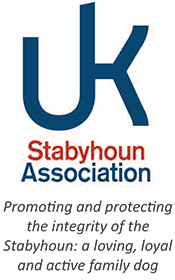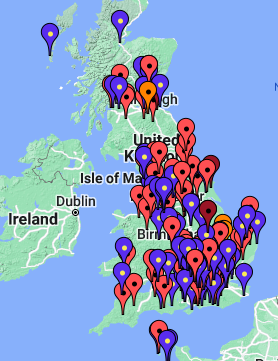So you are about to embark on a wonderful journey, your bitch is pregnant and you are going to be a first time breeder, below is a guide what to do and be prepared for when the time comes.
Firstly let me introduce myself, I grew up on a farm with pigs, goats sheep and cattle, I am a former Veterinary Nurse, and have bred dogs for many years. Over 400 puppies safely delivered to date, including German Shepherds, Border Collies, Rottweilers, Nova Scotia Duck Tolling Retriever’s and more recently Stabyhoun.
Assisting in writing this article is Hannah Woods, an Auxiliary Veterinary Nurse and breeder for over 10 years. She has bred Shelties and Stabyhoun, and assisted in whelping Spaniels, Labradors and Whippets. She has helped bring over 100 puppies into the world to date.
Please feel free to contact either of us should you need any assistance when it comes time for whelping.
I am going to talk about what to do when your bitch whelps (has her puppies). To start with you need to decide where mum is going to have her babies, a warm, quieter room away from all the hustle and bustle of daily living would be ideal.
At least two weeks before her due date you will need to set up the whelping box in that room, with plenty of bedding to make it enticing for her and to encourage her to nest. I find soft towels are ideal for this. Let mum get used to sleeping in this room overnight and have access to go in there during the day. Make sure you have everything in that room that you might need. Whelping kits can be found online which include everything you could think of for whelping, though often there’s more than you need. At a minimum, make sure you have in a ‘whelping kit’:
- Small clean towels or flannels – for cleaning up puppies if needed
- Plenty of extra bedding – ‘vet bed’ is ideal as it allows fluids to drain whilst the top stays dry.
- A bag to put soiled bedding in ready for the wash.
- Heat mat – Pet Remedy supply an excellent waterproof heat mat which is stable at body temperature, to go under bedding at the end of whelping.
- *Two pairs of mosquito forceps-for clamping cords if needed
- *A water based lubricant such as K-Y Jelly
- *A selection of syringes, starting with 1ml (can be invaluable to syringe lubricant around a puppy if needed)
- *Thermometer
- *Replacement puppy formula
- *Stethoscope
- Pen and paper to write down the time each puppy is born.
* Hopefully you will not need these items but they are very good to have so that you are prepared for all eventualities.
A comfy chair is essential and a good book as you will be in there a long time, plenty of spare clean bedding for mum, your vets emergency number just in case. It’s a good idea to let your vet know when mum goes into labour, so they’re aware that they may be needed – though hopefully not.
As she gets close to whelping, in particular a couple of days beforehand, she may have Braxton Hicks (practice) contractions, don’t be alarmed by this it is quite natural and she then will settle down for another couple of days before going into the real thing. If you monitor her temperature you will find it will drop slightly by 1 degree about 24 hours before the birth. At this time she will probably refuse food and be wanting to empty her bowels, she may also vomit. She will pant intermittently, want to nest and generally be very restless. When she does go into labour this can go on for a long time before any puppies are actually produced, in some cases up to 24 hours, especially for a first time mum. Try not to panic and let nature take its course. Just sit with her. Quite often they really appreciate having their bellies gently stroked and talk to her soothingly. Make sure you have someone else on hand to bring you cups of tea and take over when you have the call of nature, because you might find she doesn’t want to be left on her own, especially if it is her first litter and she’s not quite sure of what is going on.
If it goes past 24 hours and there’s no sign of her moving into the next stage of labour – contractions and more determined nesting efforts – then a call to your vet may be in order. After her waters break – often you will notice a puddle, you may hear a ‘pop-whoosh’, and she will pay a lot of attention to her vulva – you ideally want to see puppies within 4 hours. If she is having contractions but you don’t see or feel any puppies, it’s worth a call to your vet. If you can see or feel a puppy in the birth canal, and mum is pushing for more than 10 minutes without any progress, you may need to help her out.
When the first puppy arrives, break the sack around its mouth and slide your finger through to clear the mucus from the airways as soon as possible, as this will make it easier for puppy to take its first breath, then let mum take over she will chew the cord and lick the rest of the sack from the puppy. The afterbirth/placenta will usually follow on quite quickly (there is a separate afterbirth for every puppy) and mum will probably want to eat this, which is absolutely fine, it is full of nutrients which will give her extra energy during the rest of her labour. Repeat this for every puppy. Mum may well be protective with the first puppy, she may carry it around a lot in her mouth circling in the box, this is natural and do not worry, her mind will be taken off it as soon as the second puppy comes along. On no account remove puppies from her while she is whelping unless absolutely necessary as this will cause her undue stress and she could possibly reject the puppies later on. If she is trampling around and digging a lot in preparation for the next puppy, you could move the newborn puppies into a warm open topped box, for instance a shoebox with a warm hot water bottle and a blanket, but make sure you keep this within the whelping box so she can have access to the pups at any time, and always put them straight back with her once the next pup has been delivered. The first few minutes after a puppy is born is crucial time for mum to create a bond with her puppy. Puppies should be active within a few minutes of being born crawling around looking for the milk bar, it sometimes helps just to point them in the right direction. Don’t worry if they don’t latch straight on at this point, the pups have plenty of nutrients from the placenta and may not properly suckle until she has finished whelping. This is fine, and you don’t need to give them puppy formula in between – mums milk is far superior!
Try not to interfere too much as mum will instinctively know what to do, we are just there to monitor and help out if needed.
If you have a puppy born that is unresponsive then make sure the airway is clear and rub vigorously in a warm, dry towel to try and stimulate it. You can also try blowing some air into its mouth. Puppies born like this are often ones that are breech (born bottom first). It is not unusual for puppies to be born back feet first – about 40% will come out backward! However tail/bottom first is more tricky and often takes longer, which can lead to an unconscious puppy. You should keep working on an unresponsive puppy for at least 20 minutes in this way, and fingers crossed you will be successful. However, do bear in mind that sometimes your efforts will not be rewarded and sadly we will occasionally lose a puppy. Don’t beat yourself up – it happens to even the most experienced breeders.
If you do find that you do need to take a puppy away from mum, in order to keep her relaxed and avoid any undue stress then the best way to do it is to take two puppies away, then immediately give her one back and she won’t notice that you still have the other one.
The towels in the box will become very dirty very quickly as she is giving birth so just put clean ones down on top to make it nicer for her at this stage, as we can clean the whole lot out and give her a nice fresh bed once she has finished and the last puppy has arrived.
The gaps between puppies arriving can vary greatly. Often a few will arrive in fairly quick sucession, 10 to 20 minutes apart, but it can be an hour between each one. Often mum will take a break for an hour or so halfway through whelping, where she will sleep and first pups will feed. This is normal! I have had a gap of several hours and even once 24 hours between the penultimate and the last puppy. When the last puppy has arrived you should notice a difference in her as the contractions will stop and she will settle down with her babies. If you are in doubt you can gently palpate her abdomen to feel for any more babies in there, and if you are still concerned and think she is still having contractions but nothing arriving then contact your vet for advice.
Once all the puppies are born, we need to give the box a good clean out and put fresh bedding down for her and her babies. This is easier said than done, as she will not want to get up and leave them while you do this. I find the best idea is to get all your fresh bedding ready – I normally use a large bath sheet/towel and a large vet bed on top – then get somebody else to take mum out for a quick wee (You will probably need to put her on a lead for this) in the garden. While she is out you can quickly get all the puppies out into a suitable warm box or container, then you can swiftly replace all the dirty bedding with nice clean ones that you have got ready prepared. This is also an ideal time to place the heat mat in the box. Place it in the middle so that mum can lie around the sides of it, and the pups are on it. Put the puppies back into the box and then let mum come back in, she should then settle down quite quickly to nurse them. It is better for her to see that the puppies are unattended in the box where she ‘left them’ than for you to be handling them when she comes back in. You don’t want her to feel that her pups are threatened if she leaves – right now, instinct is ruling her and she would lay down her life to protect her pups!
Offer her some food and water – some beef or chicken broth often goes down well – and then let her settle down.
Lastly pour yourself a large gin and tonic and sit down with your feet up and enjoy the moment! You can then get a bit of sleep yourself as you probably haven’t had any for the last couple of days…
Helen Withey FBIPDT PETbc KCAI








